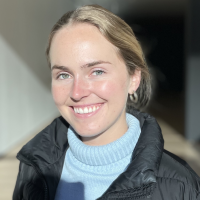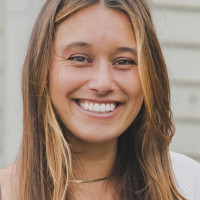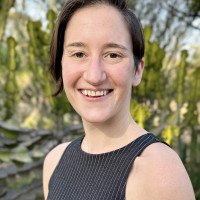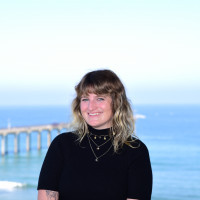Throughout 2024, California Sea Grant is showcasing our State Fellowship, which places graduate students in 12-month paid roles with the agencies and organizations that plan, implement and manage ocean policies and programs in California. This month, the fourth in the series, we’re highlighting fellows working along the Central Coast.
Monterey Bay National Marine Sanctuary
Libby Mohn

California’s Central Coast is famous for its expansive kelp forest — though lately that forest has been thinning as kelp dies off. Now, the forests are patchy, interspersed with wide “barrens” of urchins.
“We know that both ocean warming and biological changes like overgrazing by urchins have led to this decline,” says Libby Mohn, a California Sea Grant State Fellow placed at the Monterey Bay National Marine Sanctuary. “But there’s a lot we still have to learn.” As a part of her fellowship, she has convened the research group that will supply the knowledge the sanctuary needs to develop an “Iconic Kelp Action Plan.” Mohn also facilitates the working group’s meetings and will carry the plan to its completion before her fellowship ends. (In addition to leading work on the kelp action plan, Mohn is helping shape the sanctuary’s larger climate adaptation plan.)
Mohn first learned of the fellowship as a graduate student at the Middlebury Institute of International Studies in Monterey. “It seemed like a great stepping stone into the world I wanted to enter,” she says. Working for NOAA, the agency that oversees the sanctuary, has connected her to one of the preeminent players in the ocean conservation scene. Part of her work has included ensuring the sanctuary doesn’t duplicate work being done by the other conservation agencies and organizations in California. “It’s something I really wanted to learn from the fellowship: how different layers work, how they work together,” Mohn says.
Channel Island National Marine Sanctuary
Sachiko Lamen
Sachiko Lamen first discovered the California Sea Grant State Fellowship while searching for jobs after earning an undergraduate degree from the University of California, Santa Barbara, and remembered the opportunity as she began her master's degree. When the fellowship later connected her with the Channel Islands National Marine Sanctuary she immediately recognized the opportunity as a gateway to a fulfilling career. "Jobs here, and at any marine sanctuary, can be competitive since people tend to stick around," Lamen explains. "But this fellowship has allowed me to build valuable connections that make new opportunities much more accessible."

Her work, though, has looked beyond the internal office family: Lamen has organized citizen science projects, training recreational divers to survey endangered white abalone, for example. The Channel Islands have received international recognition from UNESCO as a biosphere of importance, and Lamen has worked to organize a community-based management group for this program. Her central duty, though, has been coordinating the sanctuary's Advisory Council, bringing together diverse stakeholders from commercial fishers to conservationists to inform marine management decisions. She’s learned the importance of balancing voices. "It's not just, 'Oh, let's all vote and take the majority opinion,’” she says. “There’s a big emphasis on listening to all viewpoints and encouraging open, respectful discussions to try to reach compromises that everyone can agree on. That’s a way of working that I’ll take with me wherever I go.”
Monterey Bay Aquarium
Nicky Rosenberg

Nicky Rosenberg comes from a family of scientists, but decided to forge her own path: Her bachelor’s degree is in photography, which helped launch an initial career in the creative industries. She began to channel her skills toward environmental work, and when the world paused for the global pandemic, she decided she wanted to focus even more deeply on such issues, climate change especially. So she found herself looping back toward science.
After a few years of preparation — taking science classes at a community college, volunteering at her local aquarium — Rosenberg launched a new career: She arrived at the Scripps Institution of Oceanography for a Master of Advanced Studies in Marine Biodiversity and Conservation (MAS MBC), an interdisciplinary program that has sent many graduates on to the State Fellowship.
There, Rosenberg found herself drawn to work in which science intersects with communications work and policy. Now her own fellowship experience has added a new strand to that resume: community engagement. Specifically, Rosenberg has managed a community microgrant program that has steered $44,000 toward local nonprofits, focused on projects ranging from climate justice to scientific research. She’s also developed the Aquarium's first impact framework for community engagement programs. The community engagement work is new not just to Rosenberg, but to the aquarium itself; its team was created less than a year before her fellowship started. That has made for “an extreme learning experience,” Rosenberg says, though that’s precisely what she was seeking in the fellowship. “It’s really helped me build foundational skills that will be useful wherever I go.”
Lilianna Watson
Growing up in San Diego, Lilianna Watson was always drawn to the ocean but didn’t think at first she had the skills to be a scientist. So she studied English as an undergraduate. After a stint as a communications consultant at a financial company, she too headed to Scripps’ MAS MBC program seeking new horizons.

Watson’s capstone project, a digital graphic novel about a neurodivergent teenager’s underwater journey through the Monterey Submarine Canyon, was inspired by an exhibit at the Monterey Bay Aquarium, so it felt fitting that she too was placed at the aquarium for her fellowship. She works in the education division, which runs the free programming the aquarium offers to schools.
That has allowed her to flex her communication skills: she supported the aquarium’s Vice President of Education in guest-editing an issue of the Journal of Museum Education, for example, and created an animation for the aquarium website. But she’s also been pulled into the more relational aspects of education. As a part of the aquarium’s middle school summer camp, she discussed Swim Down, her graphic novel, with visiting students. “It’s been a combination of applying my skills while also exposing me to new things,” she says of the year so far. Seeing the children’s enthusiasm has made her think that, even if she does not go into teaching, she’ll continue to work in education.
Being placed at the aquarium has also led to another important revelation. A friend recently asked where Watson would live if she could live anywhere. “And I was like, ‘Honestly, I would stay here. This is my favorite place I’ve ever lived.’ And it was nice to realize that.”